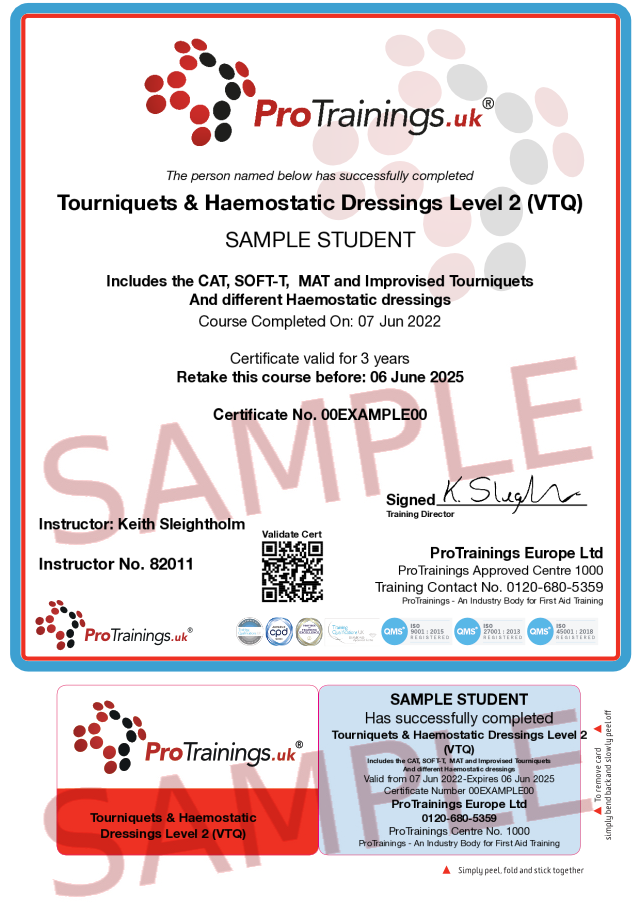Learn how to manage a casualty who requires a tourniquet
This blended part two Tourniquets and Haemostatic Dressings course is designed to teach you how to apply a tourniquet correctly.
Catastrophic bleeding is life-threatening and can kill in minutes so having a fast and effective method of stopping bleeding is a must have life skill in the workplace, out and about and at home.
This course covers the main types of commercial tourniquets including RapidStop, CAT, MAT, SOFT T, SAM XT, STAT and Improvised Tourniquets. Haemostatic dressings from Celox, Quick Clot, Axiostat and other Haemostatic dressings and powders are also included. The course also covers the use of trauma dressings including the Air Wrap dressings.
This course covers the use of the latest BSi Critical Injury Packs as listed by the HSE.
We also offer courses in Major Incident Trauma and First Person On Scene coving advanced medical care.
The content of this and all our courses has been independently certified as conforming to universally accepted Continuous Professional Development (CPD) guidelines and come with a Certified CPD Statement as well as a ProTrainings Certificate and for online courses an Evidence Based Learning statement.
The content of this and all our courses has been independently certified as conforming to universally accepted Continuous Professional Development (CPD) guidelines and come with a Certified CPD Statement as well as a ProTrainings Certificate and for online courses an Evidence Based Learning statement.
- First Aiders
- Medics
- Forestry
- CFR's
- High-risk environments
- Agriculture
- Power networks
This course comes with 3.0 hours of CPD, although the time to complete the course online may be less than this.
The content of this and all our courses has been independently certified as conforming to universally accepted Continuous Professional Development (CPD) guidelines and come with a Certified CPD Statement as well as a ProTrainings Certificate and for online courses an Evidence Based Learning statement.
- About tourniquets and Haemostatics
- The rule changes
- Haemostatic or tourniquet
- Trauma dressing
- Types of tourniquet
- What damage can tourniquets do
- RapidStop Tourniquet
- CAT tourniquet
- SOFT-T tourniquet
- MAT tourniquet
- SAM XT Tourniquet
- Improvised tourniquets
- Applying the second tourniquet
- Haemostatics
- Packing a wound
- Celox gauze
- Celox A
- Celox granules
- Other Haemostatics
- Monitoring patients
- Shock
Learning outcomes:
- LO1. Understand the difference between tourniquets and haemostatic dressings
- LO2. Explain what a trauma dressing is and when it would be used
- LO3. Explain when a tourniquet would be used and where it would be used
- LO4. Understand what damage can be caused by a tourniquet
- LO5. Explain how to use different types of tourniquet
- LO6. Explain what to do if the application of a tourniquet does not control bleeding
- LO7. Understand how haemostatic dressings and agents work to control catastrophic bleeding
- LO8. Explain how to pack a wound with a haemostatic gauze
- LO9. Explain how to use haemostatic granules to control a serious bleed
- LO10. Explain how to continually monitor a patient after treatment a catastrophic bleed
- LO11. Explain the importance of monitoring and treating for shock.
- LO12. Explain how to use a BSi critical injury pack








